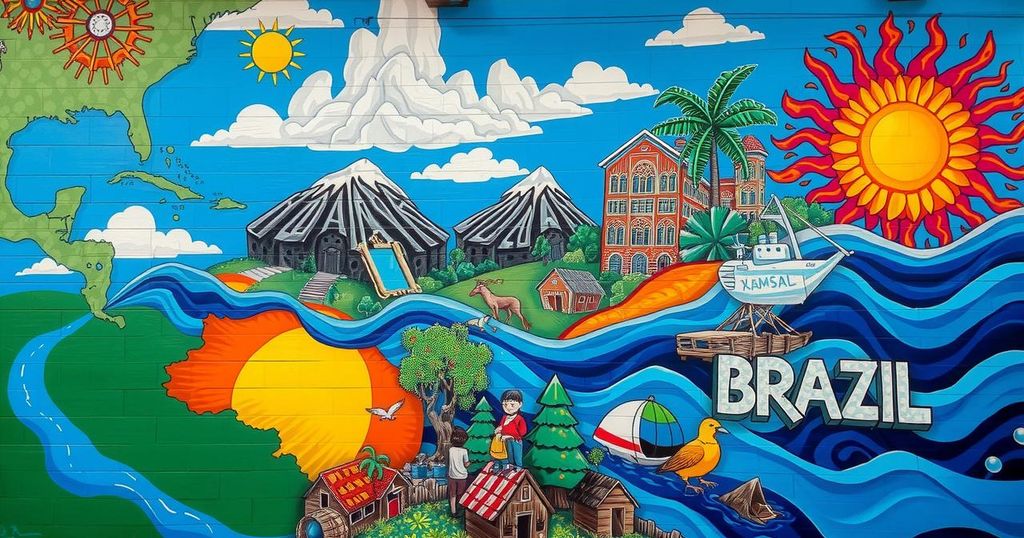Brazilian artist Mundano has created a large-scale mural in São Paulo to raise awareness about climate change. Utilizing materials sourced from natural disasters, such as ash and mud, the mural highlights the dire consequences of deforestation and severe drought in the Amazon. Featuring Indigenous activist Alessandra Korap, the mural addresses Cargill’s role in these issues, with calls for corporate accountability and environmental stewardship.
Mundano, a Brazilian artist and activist, has recently unveiled a compelling mural in São Paulo that utilizes unconventional materials sourced from the devastation wrought by climate disasters. This artwork, which employs ash from wildfires and mud from floods, serves as an artistic manifestation of the pressing issues surrounding climate change and environmental degradation in Brazil. The mural, measuring over 30 meters in height and 48 meters in width, poignantly depicts the bleak remains of trees against a parched, cracked earth, symbolizing the dire consequences of deforestation and severe drought plaguing the Amazon rainforest. Additionally, the mural portrays Indigenous activist Alessandra Korap adorned with a floral wreath, holding a sign that reads, “Stop the destruction keepyourpromise,” which is a direct appeal to Cargill, a major United States-based soybean producer. Mundano has voiced concerns regarding Cargill’s role in deforestation, stating that soybean cultivation significantly contributes to the destruction of the Amazon. While Cargill has pledged to eradicate deforestation from its supply chain in Brazil, Argentina, and Uruguay by 2025, Mundano believes that accountability is essential. In an interview, he expressed, “We are tired of being a country, a continent where we and the natural resources we have here are exploited. … We have to regenerate our planet instead of destroying it.” Recent months have witnessed significant ecological challenges, including catastrophic wildfires that have devastated protected areas in the Amazon, including the vast Cerrado savanna and the Pantanal, the world’s largest tropical wetland. These fires not only compromised these regions but also adversely affected urban air quality across various Brazilian cities. The drought situation in Brazil has also escalated to critical levels, with forecasts indicating that this drought condition may persist through much of October, as reported by Cemaden, Brazil’s disaster warning center. An alarming decline in the Negro River—recorded at its lowest level in 122 years—further underscores the severity of these climatic disturbances, illustrating an ongoing pattern of extremes from floods to droughts. Mundano’s mural serves not only as an art installation but as a social commentary, urging both the public and corporations to recognize their role in environmental stewardship, and advocating for a future where natural resources are utilized sustainably.
The mural by Mundano reflects a broader narrative regarding climate change and its tangible impacts, particularly within Brazil. The country has been grappling with increasing instances of extreme weather events, including devastating droughts and floods, significantly affecting both ecosystems and local communities. Artists like Mundano utilize their platforms to raise awareness and provoke dialogue around pressing environmental and social issues such as deforestation, resource exploitation, and corporate accountability. The prominence of soybean farming, especially by companies like Cargill, poses a critical challenge to the preservation of the Amazon rainforest and highlights the intersection of agriculture and environmental degradation. This situation demands concerted efforts from all stakeholders, including governmental bodies, corporations, and citizens, to establish sustainable practices that honor both humanity and nature.
Mundano’s expansive mural in São Paulo serves as a powerful visual critique of climate change and corporate neglect, emphasizing the urgent need for accountability from companies like Cargill in their environmental commitments. By harnessing materials derived from recent natural disasters, Mundano intertwines artistic expression with activism, calling attention to the interconnectedness of climate events and the responsibilities individuals and corporations bear in the fight against environmental degradation. Ultimately, his work challenges society to prioritize regeneration over exploitation, advocating for a crucial shift towards sustainable interactions with our planet.
Original Source: learningenglish.voanews.com






